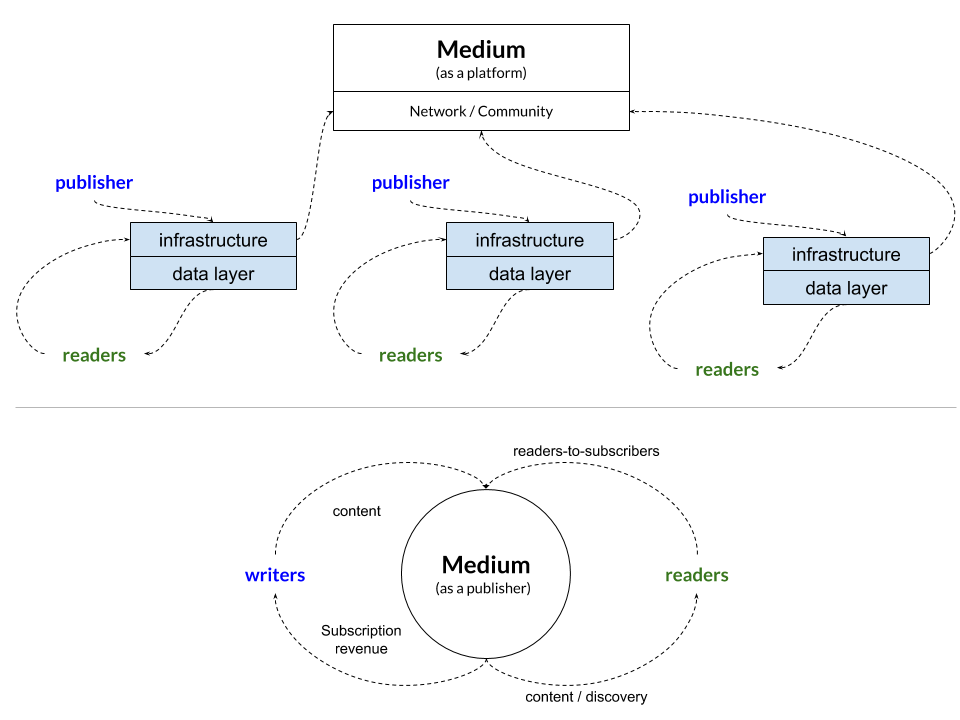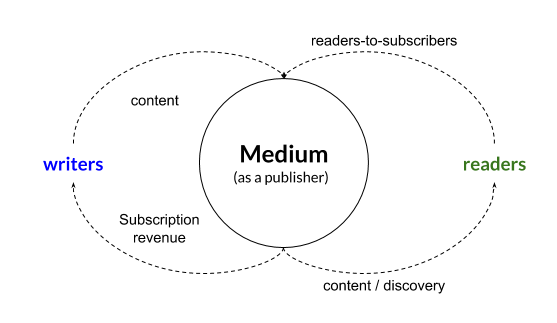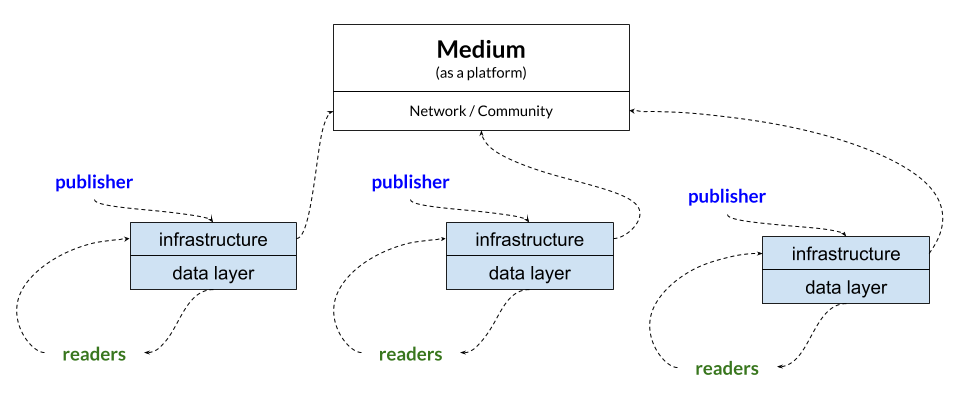Medium Business Model: A Publisher or a Platform?
Medium made it easy for anyone to publish and share content without the trouble of setting up and managing their own blog. But most importantly, it changed how we view content presentation and experience. Medium's simple and beautiful design made reading digital content fun and entertaining.

In the essay — Mediafication: How Media Rewires The World — I talk about how media facilitates economic growth of companies and individuals. Content has become a product of increasing value that is infinitely reproducible at almost zero cost.
Over the last few decades, software has become an integral part of every business. Every business is a software business. However, what might be less obvious, but more impactful, is how technology has changed and redefined the way we produce, distribute, and consume media. Like software, media is no longer limited by the boundaries of its own industry — it’s a new and important layer that underpins the economy for businesses and individuals. Today, every company is a media company.
Arguably, the impact of “mediafication” on the economy will be as great or even greater than the impact we experienced from the software "eating the world." The reason is simple — it’s much easier for individuals to produce content than to create software.
New kinds of publishers and platforms are emerging for producing, publishing, distributing, engaging, and analyzing content. And in this piece I'd like to talk about Medium and its business model.
Publishing: Editorial vs. Business
A subscription model is poised to become the primary source of revenue for publications. But there is another important trend that impacts the publishing industry. Unlike in the pre-internet era, journalists and writers have tools to build their own audiences and to create their own content experiences and destinations. Is it possible for larger publications to disintegrate into smaller one or two-person teams? I believe it's unavoidable.
In the pre-internet era, publishers consisted of two distinct operations: business and editorial. Their relationship is often described by industry insiders as "the separation of church and state." Since I'm not an industry insider, it's hard for me to say which is which. But the idea is obvious: the business side focused on generating revenue, mostly through selling ads, while the editorial side was solely responsible for creating newsworthy stories. The business side had no voice in editorial matters to avoid conflicts of interest. After all, it seems as if editorial is the state in this analogy.
The separation of church and state in publishing was required to protect the integrity of journalists and shield readers from stories influenced by corporate money. Yet, publishers that focus on subscriptions as their monetization model do not need to cater to corporate advertisers. They can just focus on creating stories and serving their readers who pay them. It further empowers journalists and writers to start their own publications. The disintegration of large publishers and the rise of independent (niche) publication trends were recognized by a few platforms that came to service them.
Medium: a publisher or a platform?
While many thought digital content publishing couldn't get any easier, Ev Williams, who co-founded Blogger in 1999 and later Twitter, launched Medium platform in 2012. In the mission statement announcing the launch, Williams highlighted three main priorities for the platform:
- Create a beautiful space to post content so that creators can focus on content and not spend a tremendous amount of time coding and adjusting content presentation;
- Improve collaboration between writers and readers;
- Help writers find their audience (1).
Medium made it easy for anyone to publish and share content without the trouble of setting up and managing their own blog. But most importantly, it changed how we view content presentation and experience. Medium's simple and beautiful design made reading digital content fun and entertaining. On the other hand, writers could see how content would be presented during the editing process. What you see in editing mode is what you get when you publish your article.
For the first time, writers could embed different types of content such as images, videos, and links without any code. It's hard to overstate how much Medium has done to improve the content experience and pushed other publishing platforms to pay more attention to it. In the world of tangible goods, product packaging is as important to the overall product experience as the product itself. Everyone who ever opened an Apple product should agree.
In publishing, content is the product and its presentation (packaging) impacts the reading experience for the audience. With tangible products, customers only interact with packaging once. I use my Apple laptop daily but I have yet to go back to the beautiful packaging that it was sent in more than a year ago. In the world of content, its presentation and delivery continuously impact the reader's experience. Just change the font for your article to something that's harder to read and you will see how your experience will be affected immediately.
Medium showed that great presentation of content online can boost the performance of already great content.
Nonetheless, it is still unclear whether Medium is a platform or a publisher. Over the years, Medium has claimed to be a platform, then a publisher, then a platform again. It launched advertising then shut it down. Medium recruited publishers, then closed its publisher's program, then opened it again. Medium can't be both a publisher and a platform. These business models are fundamentally different and require contrasting approaches, not just in how you build the product but in how you build your organizational structure.
A publisher is in the business of creating content and growing readership. Medium saw an opportunity to build a new kind of publisher. Unlike traditional publications, Medium incentivizes an army of independent journalists and writers to produce a constant stream of good quality content. The advantage of Medium's approach is that it doesn't have to employ a large number of writers or any at all. It needs to grow its readership and figure out the best way to distribute revenue from subscriptions to the writers. This long-tail approach to content creation requires a solid content discovery algorithm to help readers get the stories on the topics they are most interested in. In this model, Medium stands in between writers and readers, distributing the revenue to the former and curating the content for the latter. It is similar to the Uber model where, instead of full-time taxi drivers, it employs independent drivers that can be part-time or full-time drivers. Anyone can drive for Uber just to earn extra cash. This increases the supply side of the marketplace.

A platform, on the other hand, provides tools for publishers to create and publish content, as well as engage and grow readerships and subscriptions. The responsibility for growing audiences lies in the hands of publishers, not the platform. The value of the platform comes from making it easy for publishers to create publications and engage readers. A platform provides infrastructure and data layers for publishers, allowing them to focus on content creation and building close relationships with their customers. A platform leaves it to publishers to create content and to grow their readership and subscriptions. As a publishing platform, Medium competes with WordPress, Ghost, Squarespace, and other CMS solutions. None of them were made with a focus on the content experience or the necessary tools to grow and engage the audience.

Medium could be successful using either model but it can't be both a publisher and platform at the same time. If you are a publisher, you have to focus on content discovery and readership growth. If you are a platform, you need to focus on infrastructure and readership engagement tools while accommodating the needs of publishers, or independent writers, to manage their publications.
As a platform, Medium could also provide unique content distribution services across publications that use their platform. They could highlight and promote articles across publishers and even aggregate them on specific topics.
However, Medium doesn't seem to be eager to build a true publishing platform, or what Ben Thompson calls a faceless publisher (2). Currently, Medium limits publishers in a few very important ways that prevent them from becoming a default platform.
First, Medium doesn't allow you to connect your own domain. For many content producers, writing is a way to build a voice, brand, and following among people who are interested in topics you write about.
Second, Medium mediates the relationship between writer and reader. Writers have almost no options to communicate with their readers directly. As someone who has managed to build a small audience on Medium writing about niche topics of marketing and product growth, I find the most frustrating aspect of Medium is that you can't email your followers or send them a direct message when a new article is published. Every time a new article is published, the writer has to rely on the Medium algorithm to put the story in front of the followers and enhance distribution among potential readers who haven't heard of you.
Third, every writer who takes content distribution seriously goes through a content distribution process that includes sharing your content in the newsletters or sharing it across social media channels where you have the following already (Twitter, LinkedIn, Facebook). When readers end up on your Medium page they can follow you but there is no other way to capture your audience. There is no way to ask your readers for email. Hence all the traffic that the writer generates from distribution activities benefits Medium and its ecosystem but provides little help in accumulating and engaging audiences for writers. So every time you publish a new article you have to build readership for it practically from scratch. That's why we saw a few products on top of Medium that allow collecting emails from readers (for example, Upscribe).
It's not difficult to see why Medium's identity crisis — publisher vs. platform — became such a long struggle. Both strategies generated positive feedback from the market.
Medium-publisher provided readers with much broader and diverse content created by the army of independent writers and journalists. It's worth the subscription because you can't get content from such diverse topics from any other publication. On Medium, you can read about politics, sports, marketing, self-help, investing, parenting, economics, psychology, humor, music, and the list is practically endless. Even industry titans such as The New York Times, The Washington Post, and The Atlantic with in-house editorials can't have such breadth of topics and diversity of opinions. You will have to spend hundreds of dollars subscribing to many niche publications to get the same variety of content and you will get on Medium for a fraction of the cost. This is the same reason why traditional taxi systems can't compete with the supply of Uber and Lyft.
Medium-platform gathered interest from multiple publications because it promised to solve their tech problems. Publishers are not great at luring technical talent or managing open-source platforms or building their own to stay on the top of the design, SEO, and performance best practices. Content must be good, but so must the design and experience. Pages must load fast anywhere in the world. The latest changes to search engine algorithms must be incorporated to maximize the search traffic. The content has to be shared easily on social media and not require downloading and meddling with the add-ons or plugins. Publishers must have an easy process of adding and managing new writers, aligned with current editorial approvals and workflows. And, most critically, publishers need their writers to focus on writing engaging stories and not on managing content management systems, messing with HTML and plugins, and resizing images. Yes, resizing images in WordPress is still a thing.
In addition, consider the technical aspect of shifting toward a subscription revenue model. Publishers must collect payments, manage subscriptions, gather usage analytics and personal preferences, and provide limited content free to generate audiences ready to subscribe.
But while Medium-platform tried to become a default platform for publishers of any size, it forgot one important caveat that we talked about earlier. Publishers, big or small, must own the relationship with their readers. It's not a nice-to-have, it's a must. Communicating with and receiving feedback from your audience is the key to building a successful publication.
Medium-publisher, like any publisher, must control the relationship with readers. Medium-platform must allow publishers to communicate directly with the readers. These goals are at odds with each other. Medium has to decide which path to choose to be successful. Trying to be both is the road to mediocre products at the least and failure of the company at most.
So when Medium doubled down on their goal to be a publisher it wasn't surprising to see publications leave. It's not only traditional publishers that left — The Ringer leaves for Vox, Backchannel moves to Wired, ThinkProgress leaves for WordPress — but also companies that built their blogs on Medium such as Signal v Noise by Basecamp, who left for WordPress. The momentum for Medium to build the next publishing platform for subscription generation was lost.
If you are interested in reading more about media and publishing trends read Mediafication: How Media Rewires The World essay.
Thank you for reading and sharing.
